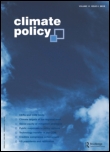National climate change mitigation legislation, strategy and targets: a global update
Iacobuta, Gabriela / Navroz K. Dubash / Prabhat Upadhyaya / Mekdelawit Deribe / Niklas HöhneExternal Publications (2018)
in: Climate Policy 18 (9), 1114-1132
DOI: https://doi.org/10.1080/14693062.2018.1489772
Information
Global climate change governance has changed substantially in the last decade, with a shift in focus from negotiating globally agreed greenhouse gas (GHG) reduction targets to nationally determined contributions, as enshrined in the 2015 Paris Agreement. This paper analyses trends in adoption of national climate legislation and strategies, GHG targets, and renewable and energy efficiency targets in almost all UNFCCC Parties, focusing on the period from 2007 to 2017. The uniqueness and added value of this paper reside in its broad sweep of countries, the more than decade-long coverage and the use of objective metrics rather than normative judgements. Key results show that national climate legislation and strategies witnessed a strong increase in the first half of the assessed decade, likely due to the political lead up to the Copenhagen Climate Conference in 2009, but have somewhat stagnated in recent years, currently covering 70% of global GHG emissions (almost 50% of countries). In comparison, the coverage of GHG targets increased considerably in the run up to adoption of the Paris Agreement and 89% of global GHG emissions are currently covered by such targets. Renewable energy targets saw a steady spread, with 79% of the global GHG emissions covered in 2017 compared to 45% in 2007, with a steep increase in developing countries.
Key policy insights
The number of countries that have national legislation and strategies in place increased strongly up to 2012, but the increase has levelled off in recent years, now covering 70% of global emissions by 2017 (48% of countries and 76% of global population).
- Economy-wide GHG reduction targets witnessed a strong increase in the build up to 2015 and are adopted by countries covering 89% of global GHG emissions (76% not counting USA) and 90% of global population (86% not counting USA) in 2017.
- Renewable energy targets saw a steady increase throughout the last decade with coverage of countries in 2017 comparable to that of GHG targets.
- Key shifts in national measures coincide with landmark international events – an increase in legislation and strategy in the build-up to the Copenhagen Climate Conference and an increase in targets around the Paris Agreement – emphasizing the importance of the international process to maintaining national momentum.


